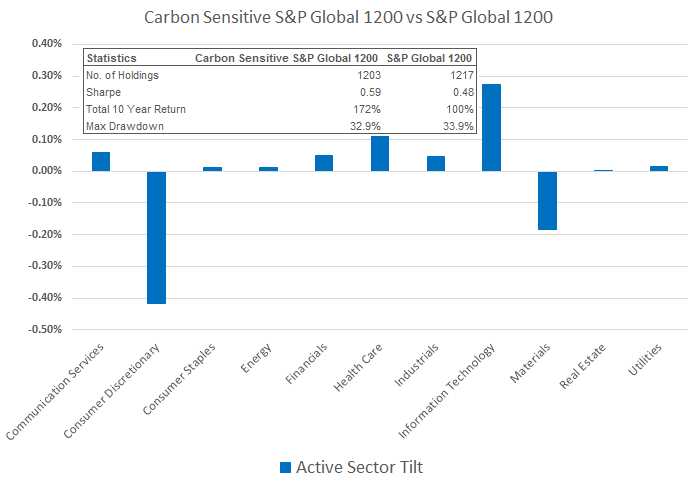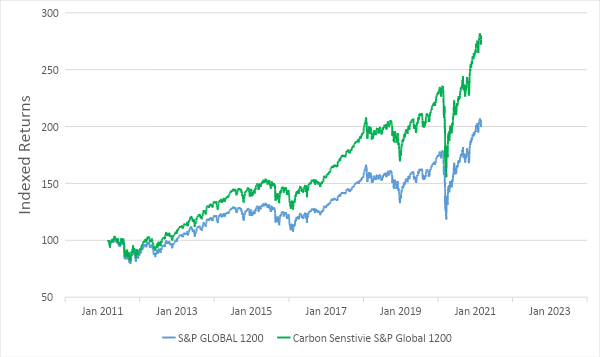This is the third blog in series examining the steps portfolio managers need to take to reach the goal of net-zero carbon dioxide emissions in their investment strategies by 2050. Previous blogs defined net-zero and looked at the creation of a carbon footprint. In this blog, we address how to optimize a portfolio so it is carbon sensitive.
Power your net zero journey with essential intelligence
Speak To A Specialist >As we mentioned in our last blog, market participants constrained by the characteristics of their investable universe/benchmark can still manage their exposure to carbon. Environmental attribution analysis of portfolios or benchmarks shows that positive or negative carbon choices are possible within sectors/industries/regions/countries through low/high-carbon stock selections. With quantitative procedures and consistent data at hand, portfolios can be optimized to favor more carbon-efficient companies, while still maintaining the underlying characteristics of their investable universe/benchmark.
Several academic studies document that companies with lower carbon emissions actually have higher profitability levels than companies with higher emission activity.[1] Highly profitable firms are usually well managed, and have the resources to adopt proactive environmental strategies as a way to decrease regulatory liabilities, mitigate business risks, and manage important stakeholders. In addition, optimizing energy use, either through the use of new energy-efficient equipment or by adopting energy conservation policies, has the added benefit of reducing pollution, as carbon emissions are correlated to energy consumption.
Portfolio Optimization Framework
The goal is to construct a carbon sensitive-portfolio — that is, a portfolio with lower C/R Intensity, lower C/V Intensity, Lower WACI and lower apportioned carbon emissions, but similar risk, return, and fundamental characteristics of the investable universe/benchmark. Apportioned Carbon Emissions is a measure that allots greenhouse gas emissions by the underlying ownership of the company and aggregates allotments to the portfolio level.
For the purposes of this blog, we are using the S&P Global 1200 as the starting portfolio/benchmark for carbon reduction, but any portfolio of securities can be used. The carbon-sensitive portfolio that we are deriving from the S&P Global 1200 uses a mean variance-based optimizer, where Scope 1 and 2 carbon emissions are used as an optimization constraint to lower the overall carbon emissions of the portfolio by under/overweighting high/low Scope 1+2 carbon companies. This is done while still maintaining the sector, country, risk, and return characteristics of the underlying S&P Global 1200.
In Exhibit 1, we show the C/R, C/V, WACI and Apportioned Carbon Emissions of the carbon-sensitive S&P Global 1200 and the S&P Global 1200. We see that the carbon-sensitive S&P Global 1200 has 10.43% lower C/R Intensity, 13.3% lower C/V Intensity, 6.9% lower WACI and 13.1% lower apportioned carbon emissions (as of March 2021) at 136,000 tons of Co2.
Exhibit 1: C/R, C/V, WACI and Carbon Apportioned by Scope

Source: S&P Global, March 25, 2021. For illustrative purposes only.
In Exhibit 2, The Carbon Sensitive S&P Global 1200 still maintains the underlying characteristics of the S&P Global 1200. Interestingly, when we back-tested the carbon optimization on a monthly basis over the past 10 years, the carbon-sensitive S&P Global 1200 returns 172% versus the S&P Global 1200 of 100% (see Exhibit 3).
Exhibit 2: Carbon-Sensitive S&P Global 1200 versus the S&P Global 1200, Component Details

Source: S&P Global, March 25, 2021. For illustrative purposes only.
Exhibit 3: Carbon-Sensitive S&P Global 1200 versus the S&P Global 1200, Indexed Returns

Source: S&P Global, March 25, 2021. For illustrative purposes only.
So, does sustainable investing come at a cost or and should investors be fearful around performance concessions of green portfolios? This example shows that carbon-sensitive portfolios do not have to stray from risk and return characteristics, while improving climate characteristics when compared to portfolios constructed without carbon emission considerations.
For further reading, click here to read "The 'Trucost' of Climate Investing: Managing Climate Risks in Equity Portfolios."
[1] Delmas and Nairn-Birch (2011); In, Park and Monk (2017).


